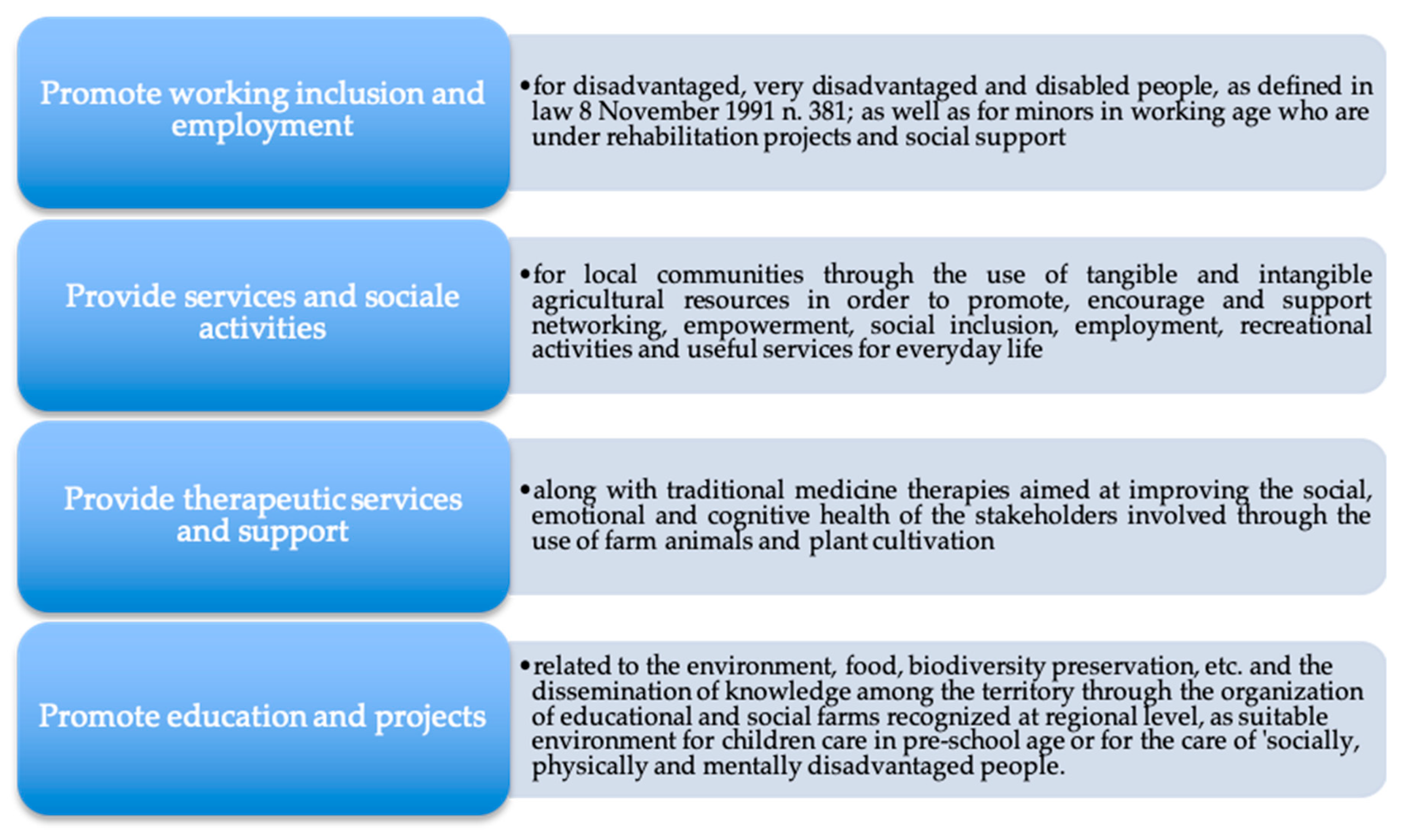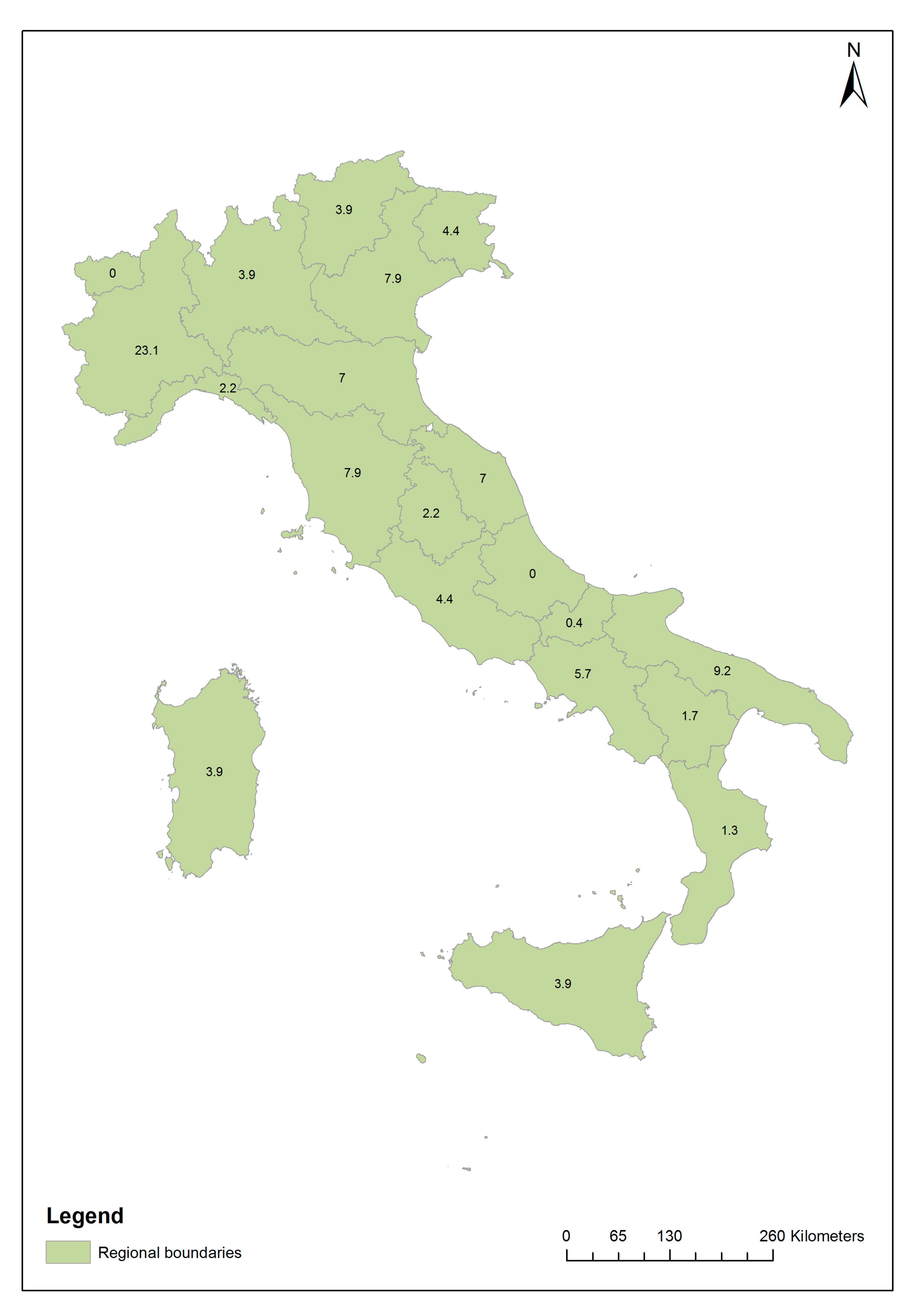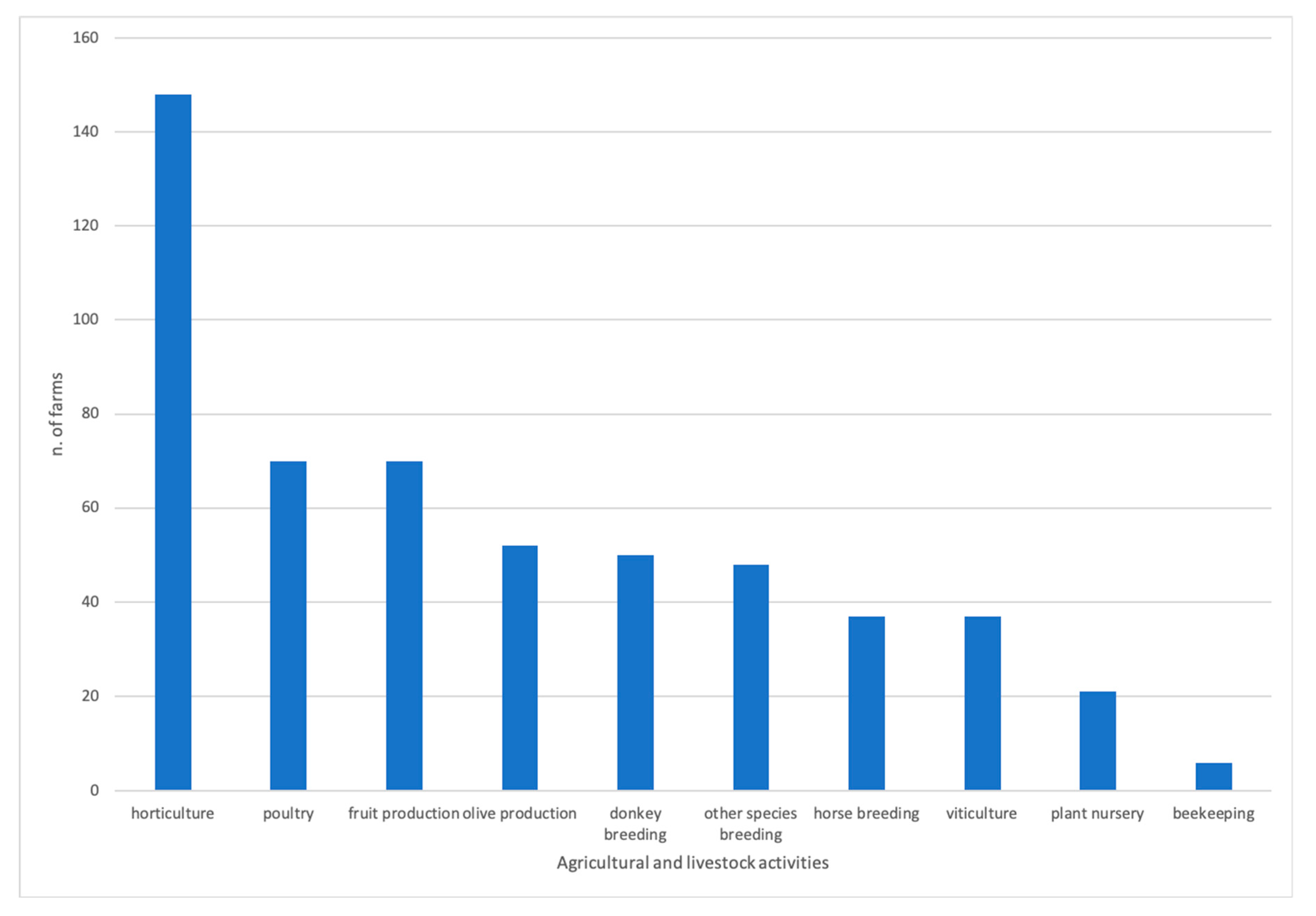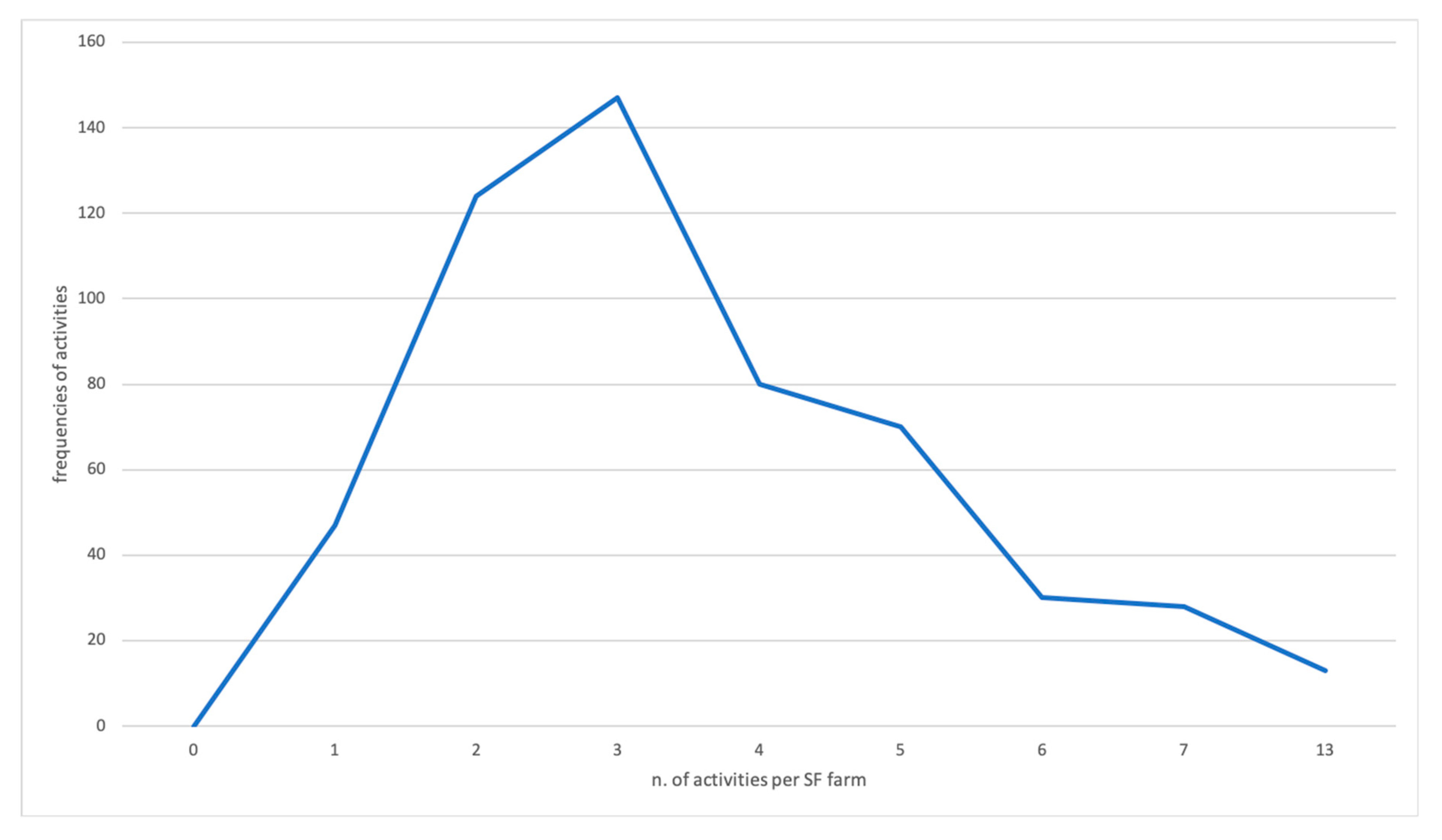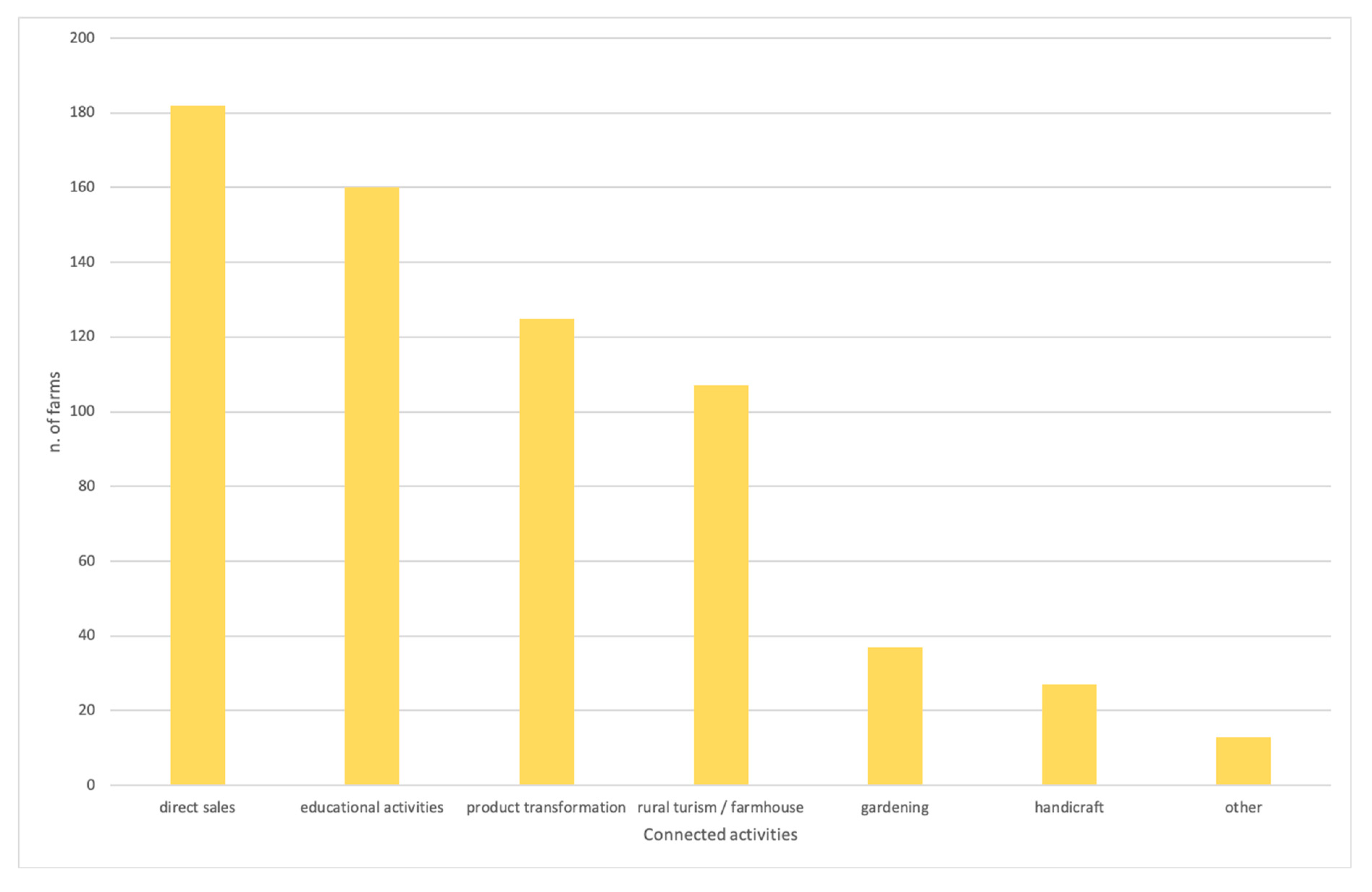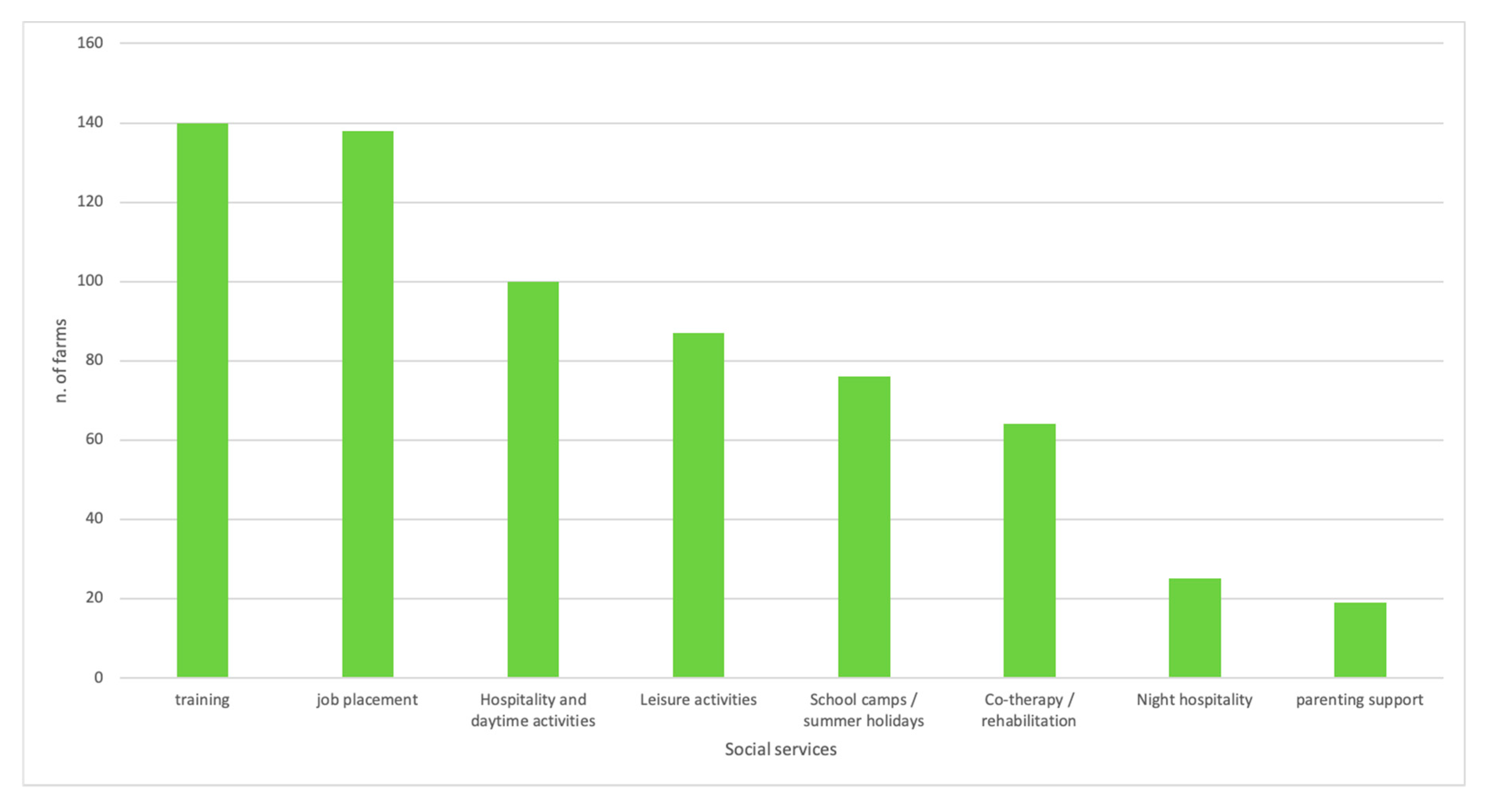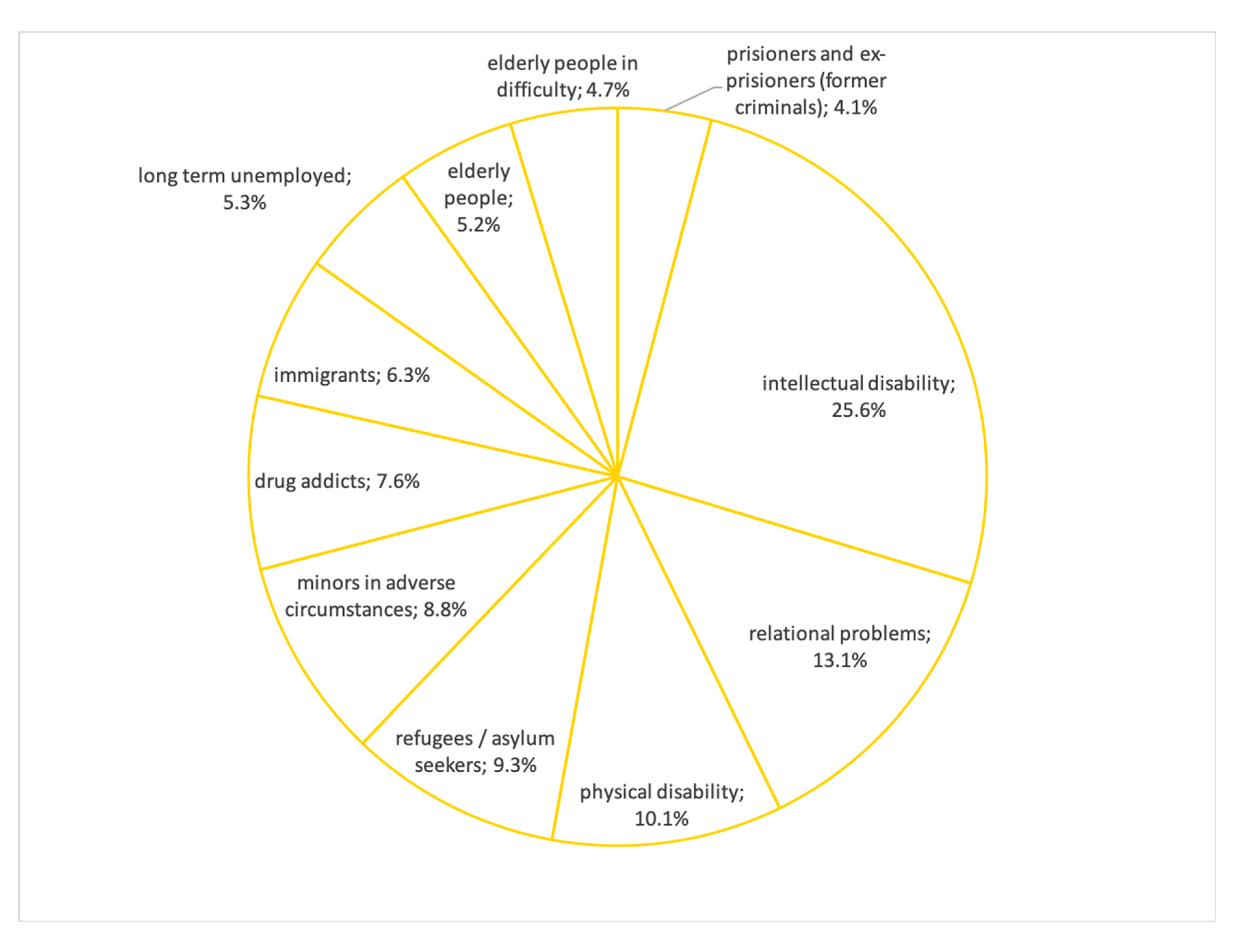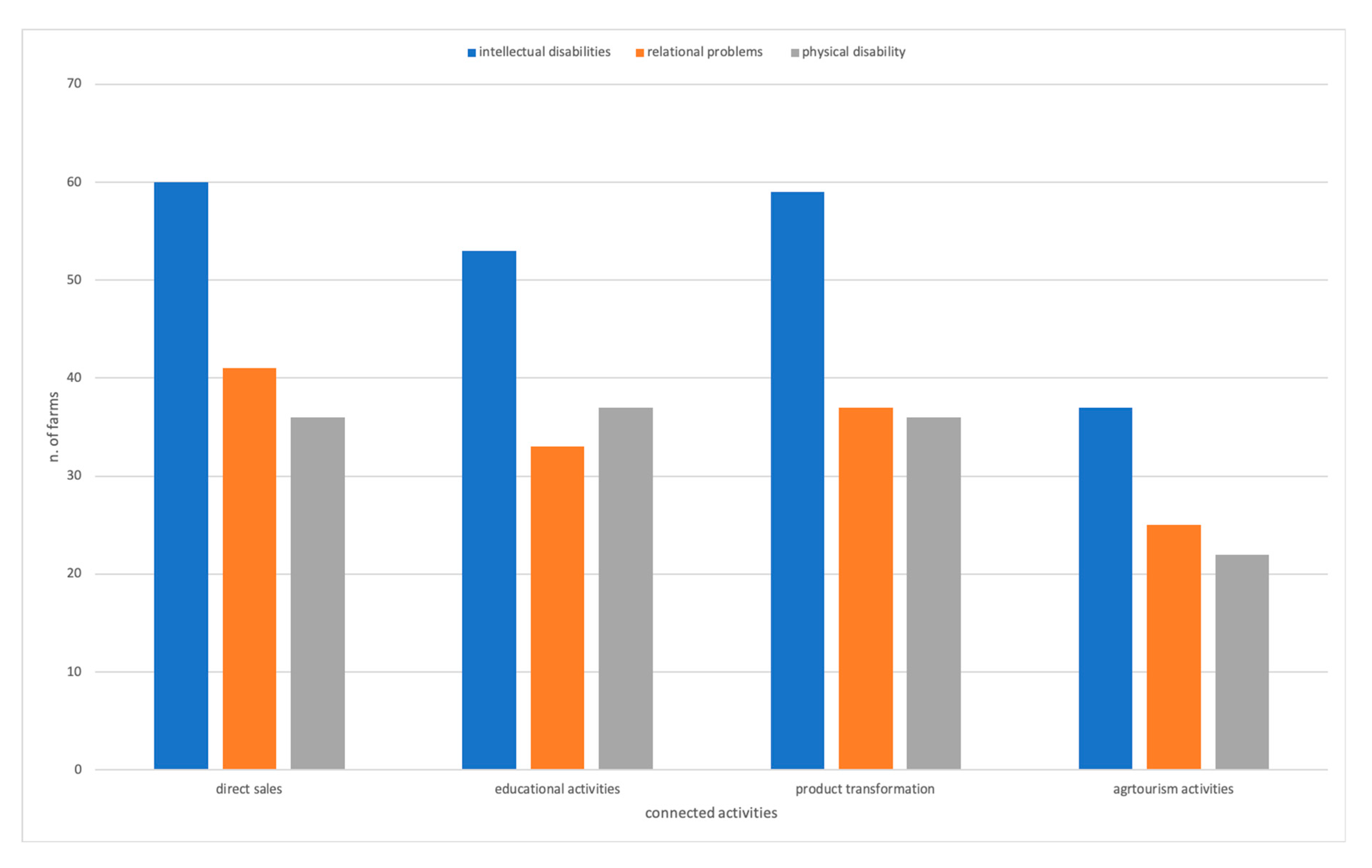1. Introduction
The development of social farming (SF) is connected to the emergence of visions that link the need for relationship-based and community approaches with aspects such as the multifunctionality of agriculture, the construction of new welfare hypotheses, and the adoption of innovative tools for the provision of services capable of responding effectively to people’s needs [
1]. More specifically, SF practices go beyond the multifunctional role of agriculture [
2] and have an impact on the communities of rural and peri-urban territories by offering a variety of services, both existing and potential ones, which have the capacity to positively affect the welfare system [
3].
The SF phenomenon is quite heterogeneous because of the characteristics of the entities involved, the legal structure of the projects, public-private financing and collaborations, and the applicable social policies. Di Iacovo [
4] points out that there is a clear differentiation, both in the stage of SF development and the typology of the initiatives, between the models implemented in central and northern Europe and those of southern Europe. In northern European countries, care farming practices (which also include social farming practices) are an important element of welfare, recognized by public policies and paid to farmers accredited to the national health system as an activity of economic diversification. It is also recognized by the national welfare as a diversification of services offered by people. In France and Germany, similarly, they are supported by the health service and entrusted to third sector entities in structures with a high sociosanitary prevalence [
5]. In some southern countries (Spain, Portugal, and Greece) the state occupies a subsidiary position and it falls to the third social sector and other entities to promote social farming and establish support networks [
6].
The situation in Italy seems completely different and, in several aspects, much more coherent with the debates on rural welfare [
4,
5,
7,
8,
9,
10], as well as being in line with the need for a regenerative welfare model based on public-private collaboration, the creation of networks, and the identification of shared solutions to tackle complex problems [
11,
12]. As a matter of fact, in rural areas, the creation and distribution of traditional value, based on the state and the market, cannot ensure development, which poses the need for moving towards an innovative and pro-active vision of welfare as a tool for local development, based on a redefinition of existing models with a focus on service and integration between sectors and resources. There is also a transition process towards collaboration between the state, the private sector, and civil society, and a growing role of the community and informal networks in the management of the services offered [
13].
Thus, the same activity can take on various forms depending on the territorial context, at the same time creating multiple concepts that shape a complex and heterogeneous phenomenon. Different terms are often used to describe this activity; generally, the term green care [
14] is used to refer to a wide variety of interventions such as nature-based rehabilitation, care farming [
15], social farming, farming for health [
16], therapeutic horticulture, and animal-assisted intervention [
17].
Social Farming (SF), in particular, has been defined by various authors. Related to these definitions, as argued by [
18], “SF not only promotes improved quality of life but also contributes to the creation of new local development strategies [
19], forming alliances between agriculture and social care, generating new models of care and welfare, and promoting the creation of new personal services in rural areas [
20]”. In fact, in rural areas, SF is able to fit local services demand by reinventing connections among the public protection net and informal support from responsible farms and civic groups. It mobilizes local non-specialized and, in some way, also unexpected resources to renew and reinforce the public protection net, especially in a phase of fiscal crisis.
Accordingly, [
21] distinguish three basic premises on which social farming practices are built: “multifunctional agriculture”, “public health”, and “social inclusion”. Indeed, social farming is characterized by the multifunctional role of agriculture in the field of personal services, alongside the traditional production function [
22]. It has the ability to generate benefits for vulnerable people, delivering innovative services that can effectively tackle the weaknesses of the traditional welfare system and respond to the growing request for personalized and qualified social services.
At the same time, by activating assets that otherwise would not be dedicated to the service of people, SF generates three types of advantages:
In a widespread way in rural areas, and thanks to the extensive presence of farms, it improves the social protection network for users who often have difficulty accessing other services, including conventional ones [
23];
Being coordinated by public services, it enriches them with human, structural, and procedural resources that ensure greater flexibility of response even in the face of diminished financial resources;
Being carried out in non-formal places, it makes way for active social inclusion paths for the people involved, making them participants in community life and promoting social justice [
17].
2. Literature Review: Social Farming Experiences in Italy
The Italian national law on SF (n. 141/2015) clearly separates SF from other green care practices. Social farming refers to the activities carried out by farmers (article 2135 of the Civil Code), individually or in groups, and by social cooperatives (under Law n. 381, 8 November 1991). The guidelines relating to paragraph 4 of article No. 2 of this law are shown in
Figure 1.
As indicated in SF Law, social farming activities, by combining the agricultural environment with rehabilitation and care services, benefit peoples’ quality of life and their social inclusion. At the same time, they represent an opportunity for farmers to broaden and diversify their multifunctional agriculture, to open up new markets, and offer alternative services that go beyond food production.
Considering the public focus of social agriculture, the Law encourages the role of public bodies in the development of these activities and the cooperation between public institutions, farms, and non-profit organizations. These practices find their application in the territorial social protection networks that, in this specific case, activate to mobilize the resources that SF can offer.
As argued by [
24], the Italian law outlines a space to share experiences about the development of a program that integrates policies among farms, services, and local institutions. This way, social farming goes beyond the multifunctional role of agriculture and has a direct impact on those communities of rural and peri-urban territories that already count on an existing offer of services, which in turn has the potential to positively affect the welfare system as a whole. In any case, agriculture emerges as a social innovation practice useful for strengthening the provision of services in rural areas, but also for revitalizing networks and relationships at individual and community levels [
18].
The presence of an agricultural business with its economic capacities linked to the agricultural management of the territory allows it to make use of economies of scope with regards to resources, processes, and structures already available for other uses, which can be made available to communities and individuals with lower contractual power in a joint or alternative manner [
12].
However, the cost and workload associated with SF practices can change according to the activities that are organized [
25]. They can be relatively limiting in the case of training and job inclusion of long-term unemployed people, prisoners under alternative punishment, refugees, and people with disabilities, because people need to be supervised and accompanied in the development of the various agri-zootechnical processes that take place on the farm. These practices can become more demanding, in terms of the socio-educational and assistance skills required, in the context of social inclusion actions for people with significant disadvantages and co-therapy activities with plants or animals. Furthermore, in the case of services dedicated to minors or families (kindergartens, nurseries, and other hybrid types) it is clear that professional staff and dedicated resources are required, and there are activate direct costs that need to be paid. Additionally, the temporary use of already existing and authorized structures such as agritourism residences, facilities for the supply of meals, and places for meetings, which are often required to attend the needs of self-sufficient rural communities or by the managers of the local services in the context of various coordinated activities, might require specific compensation.
Taking into consideration this path variability and the advantages/disadvantages that can come up, it would be extremely useful to have a viewpoint from the development of SF. A more precise analysis would allow us to reflect on many aspects connected to the reformulation of innovative hypotheses on rural welfare, such as the understanding of the roles and interactions between institutional actors, the positioning and the cultural reference of the public and private actors involved and their way of interacting, the levels of collaboration/competition among individuals, the understanding of the roles necessary to innovate and the ability of the various stakeholders to cover them, and the ways of monitoring and evaluating the results of the paths undertaken. This analysis represents a useful step in this direction, providing a further contribution to the knowledge of SF at a national level that provides some insights for a more in-depth study of the topic.
Previous researchers have analyzed the development of Social Farming in Italy. SF began to be monitored, at least at a European level, in 2004 with the establishment of a network to promote the exchange of knowledge called "Farming for health". Later, in 2007, a project called "COST Action 866 Green Care in Agriculture" was launched to investigate the concept of green care (of which SF is part) and its development in many European countries [
14]. COST was the first project that formalized green care as a scientific discipline. Subsequently, another project was funded within the VII framework program, 2006–2009, called SoFar (Social Farming in Multifunctional Farms); more recently another INTERREG project was developed, called SoFab (Social Farming across Borders), 2014–2017. All these scientific initiatives resulted in a series of publications. Considering the general purpose of these publications, the articles that evaluate health interventions are the most widespread, while the studies that explore the concept, development, and implementation of this discipline are still limited (27%) [
17]. If we consider the ones made on the national territory (8%), for the most part in Italian, only a limited number focuses on the spread of SF at a territorial level [
26,
27,
28]. Even though SF in Italy has become increasingly consolidated, it is still little known or explored concerning the number and characteristics of the individuals who implement and practice it, because of its multiple territorial expressions and declinations. Unfortunately, information about SF operators is also lacking in regions whose regional laws have considered the use of official lists, but which at times have not yet established an adequate registration system or have provided the registration of a limited number of farms, which does not reflect reality. In recent years, some studies [
29,
30,
31,
32,
33,
34,
35] have tried to provide information—mostly partial—on the experiences of SF present in Italy in order to understand the size of the phenomenon and its characteristics.
A survey [
36], conducted as part of the activities of Rete Rural National, 2007-2013, collected information from among 437 operators. Additionally, in 2016 the Council for Agricultural Research and Analysis of Agricultural Economics (CREA) established a database of about 1200 social agriculture operators, drawing on different sources, although it was not exhaustive and not always consistent with the current regulatory provisions. In June 2016, AiCARE (The Italian Agency Responsible for Campaigning and Ethics), launched an interactive online map on agri-social culture, which added to the information and divulgation efforts related to SF carried out through more than ten years; this map, which counted on 130 experiences as of 31st of July 2017, offers an interesting representation of SF at a national level [
33]. The search was also extended to gray literature, including students’ thesis reports, policy documents, and books or reports published by the main Italian SF and farming organizations (e.g., Social Farm Network and National Forum of Social Agriculture).
This paper provides a further contribution to the knowledge of this type of activity and opens up the way to deeper considerations on the topic. In particular, this study aims to reach a better understanding of the development of SF in Italy through the perspective of a national network of farmers (Coldiretti, the main organization of agricultural entrepreneurs in Italy) and to compare SF practices across regions to examine their similarities and differences. In the results section, some recommendations to further develop the sector of SF in Italy are listed.
3. Methodology
The data used in this analysis comes from a project born in 2018 and carried out by Fondazione Campagna Amica, a foundation promoted by Coldiretti, the main organization of agricultural entrepreneurs in Italy.
The project aims to help agricultural businesses in the process of SF membership and to strengthen the institutional dialogue (national and regional). It also aims to build a shared vision on the subject of SF and to increase the visibility of the products/services offered by the farms involved in this process.
The paper presents a complete analysis of SF practices developed by the national network of farmers involved with Coldiretti and Campagna Amica that took part in the project. A mixed research methodology involving quantitative and qualitative methods was formulated and executed by the Campagna Amica Foundation in collaboration with the Department of Veterinary Sciences of the University of Pisa and with Agriculture Rural Brokers (ARB), an association for innovation in agriculture and development of rural areas.
The collection of, both qualitative and quantitative, data enabled a more complete analysis of SF practices. Qualitative research carried out through interviews with key informants was integrated along with quantitative research. This strategy allowed us to better identify the actors to be involved in the quantitative method and analyze more efficiently the data collected in the case study. Considering that the key informants contacted had experience in the field of social farming, they played an important role in making suggestions for the development of the questionnaire and the analysis of the data. The information collected during the interviews with the key informants are reported in the text of the paper in italics between commas.
The "key informant approach" was used for qualitative research [
37]. This technique is based on the identification of the so-called key informants, who are individuals chosen based on their professional and social role in the community subject to investigation. They are considered a valuable source of knowledge and information that derives from their involvement and connection to the community, which represents a key factor for researchers [
38]. Therefore, they are considered "natural observers" who can help the researcher make contact with other stakeholders in the community and get them involved in the research. Key informants can provide knowledge as "experts", given their status and role in the community and are often seen as a reliable channel by which the needs of the community can be expressed [
39].
Some criteria were established to choose the key informants who would be involved in the research. Some of these were: their role in the community, their capacity to provide the researchers with the type of information they were looking for, their level of knowledge and ability to access the desired information; and their willingness to cooperate, as well as their communication skills related to the ability of communicating and transferring their knowledge understandably and impartially to the researcher.
These characteristics led to the identification of some representatives of the Coldiretti regional offices involved in SF, one for each region. Although such interviewees came from a specific region, they were also national experts in SF, therefore they provided information on the local, regional, and national aspects of SF in Italy. These informants provided an initial list of direct actors to be involved in quantitative research, validated the questionnaire, and made themselves available to stimulate these actors in completing the questionnaire. In particular, between July 2018 and March 2019, an analysis started within the network of the farmers belonging to Coldiretti and Campagna Amica through in-depth interviews. A questionnaire was administered using Computer Assisted Web Interviewing (CAWI) methodology to about 500 agricultural farms operating in SF, spread throughout the national territory.
The questionnaire, composed by closed-ended questions, was divided into four sections:
Individual characterization of the sample;
General information about the farm (e.g. size and types of crops);
Social activities carried out;
Public services performed by the farm, trying to understand which activities make it multifunctional.
The questionnaire was administered in Italian via the internet; the observable advantage offered by the online surveys was linked to a potential decrease in response times and costs.
As mentioned above, our sample is related to all agricultural farms operating in SF belonging to Coldiretti: The complete list is related to 500 enterprises. We contacted everyone through questionnaire online, but some farmers did not respond to our questionnaire and a lot of data were missing. In detail, we obtained a complete database where, for each record, all fields were filled in, without missing anything. We also checked the correctness by limiting errors in entering or updating the data as much as possible. The uniqueness of the database (one respondent corresponds to one record) was assured by permitting only one answer per farm. With the help of key informants, we revised all questionnaires and finally, for the analysis, we obtained 229 valid questionnaires.
4. Results
To evaluate the development of SF in Italy, considering the enormous variability of the farms examined, the data were analyzed from different points of view.
General analysis was performed using Microsoft Excel. The aim was essentially to give an overview of the data obtained from the interviews, to identify the characteristics of the farms, and understand which types are most active in social farming, as well as to examine their experience in this field. How long these farmers had been participating in SF and the types of services activated were also analyzed. To this purpose, combining the information obtained from the interviews with the farms’ characteristics (also considering their locations), it was possible to give a cross-reference of the data.
Thanks to this precise reading, it was possible to examine SF activities from an economic, social, and environmental point of view, drawing conclusions examined in
Section 5, which allowed us to reflect on many aspects connected to the reformulation of innovative hypotheses on rural welfare.
The farms examined, sorted by region, are mainly located in Piemonte (53 farms), Puglia (21), Toscana, Veneto (18), and Emilia Romagna, Marche (16). In two regions (Valle d’Aosta and Abruzzo) there are no farms operating in SF belonging to Coldiretti or no valid answers to the questionnaire were obtained.
Figure 2 shows the percentage of farms examined per region.
4.1. Characteristics of the Farms
The farms implementing SF activities are mostly individual farms (58.5%), “which is in line with the current trend in the Italian agricultural sector”. Piemonte, Puglia, and Campania have a higher number of SF activities registered as individual farms (respectively, 38, 14, and 10). Followed by 21% agricultural companies, 16.2% cooperatives, and 2.2% joint-stock companies.
Unlike the national average farm size (about 7 hectares), the farms operating in SF show an average surface equal to 24 hectares of Utilized Agricultural Area (UAA). The sample is well distributed among various classes of UAA, and “although they were not as predominant as it was believed in the past”, there was also a participation of micro-farms under 5 hectares (27.5%), and farms over 50 hectares (12.2 %).
The agricultural production of SF farms is very diversified and well managed in most cases (78%), with environmentally friendly production methods (e.g. integrated, biodynamic, or certified organic agriculture) being a “
sign of the strong link between social agriculture and environmentally friendly techniques”. A great variety of agricultural activities and livestock systems were represented, with a clear predominance of horticulture performed in 148 farms, mainly located in Piemonte (27 farms), Veneto (15 farms), and Toscana (12 farms). It is followed both by fruit production, performed in 70 farms, mainly located in Piemonte (20 farms), Veneto (10 farms), and Emilia Romagna (6 farms) and poultry performed in the same number of previous ones; these farms are mainly located in Piemonte (13 farms), Veneto (9 farms), and Friuli Venezia Giulia (7 farms). These results are shown in
Figure 3.
Considering which activities are mainly present in the same farm, it is important to note that horticulture, poultry, and fruit production are the main three activities simultaneously present in the same farm (frequency equal to 147), followed by farms that simultaneously perform two activities (horticulture and fruit production with a frequency of 124), and farms that simultaneously perform four activities (horticulture, poultry, donkey breeding, and others species breeding with a frequency equal to 80). These frequencies are shown in
Figure 4.
Statistical analyses on frequencies, related to the main activities of farms, were carried out using a non-parametric method, the Chi-squared test: Observed frequencies were compared with expected frequencies. Considering both the critical value approach and the p-value approach, the differences were resulted as statistically significant (p < 0.005).
The statistical analyses were conducted using Stata for Mac V13.0 (StataCorp LLC, College Station, TX, USA).
“In general, SF farms prefer activities that give more value to manual work than to the mechanized one, freeing themselves from seasonality, providing in this way activities during both the winter and summer periods”. Only 22% make use of exclusively family labor, while 78% of the farms surveyed turn to various types of collaborators “including volunteers, which are not common in the agricultural sector but whose presence is certainly in line with the ethical dimension of SF farms”.
4.2. Farm Vertical Diversification
Sixty-one percent of the sample analyzed is represented by farms that have been involved in social farming for at least 10 years, “their pioneering practices have been consolidated over the years and for this reason, they are of great interest for this investigation”. Piemonte has a higher number of consolidated SF farms (31) followed by Puglia (13) and Toscana (11). Of the sample, 14.4% is made up of farms operating in this sector for at least six years, while 23.6% was considered as a "start-up" (that is, operating from between one to five years in the sector). They are mainly located in Piemonte (13 farms), Emilia-Romagna (7), and Veneto (6).
These farms combine agricultural and/or livestock production activities with one or more connected activities “
that allow the diversification of the tasks available for social purposes” (
Figure 5) along with the consequent production diversification. Among the connected activities, the most widespread is direct sales (carried out in 182 farms), “
it allows farms to intercept target customers who are more sensitive in recognizing the added value (ethical value) in social farming products (i.e. consumers that allocate a higher value to social farms)”. As in the previous analysis, Piemonte has a higher number of direct sales farms (41) followed by Puglia and Toscana (18) and Veneto (14).
SF farms involved in didactic activities are 160: they are mainly located in Piemonte (37 farms), Veneto (13), and Puglia and Marche (12). The farms involved in product transformation are 125 and they are mainly located in Piemonte (27 farms), Toscana (15), and Puglia (13). Agritourism activities are carried out in 107 farms: in this case, Piemonte has the higher number of farms involved in farmhouse activities (17) followed by Toscana (12) and Marche (10).
As in the previous subsection, we performed statistical analyses on frequencies related to the main connected activities: For instance, statistics were carried out on direct sales, educational activities, product transformation, and agritourism activities using the Chi-squared test. Also in this case, observed frequencies were compared with expected frequencies. Considering both the critical value approach and the p-value approach, the differences were resulted as statistically significant (p < 0.005).
“To encourage the propensity to "use" the activities related to the purposes of social farming, there is certainly the possibility of taking advantage of the facilities and indoor spaces, which are highly appreciated by users during the most intense climatic periods (winter and summer) to use them in the agricultural activities carried out in the field”. Other spaces used for SF activities are classrooms, sale points, equipped recreational spaces, and laboratories.
Moreover, SF farms are multi-channel farms, in which the interaction between the farm and customers is done through the integration of multiple channels, both without any intermediaries (short sales channels) and with the presence of intermediaries. “The solidarity purchasing groups represent places of choice for the products of social farming and play a fundamental role at a commercial level, which is linked to the social awareness in the act of purchasing from the citizen”. “The national network of Campagna Amica markets also represents an opportunity for social farming: SF farms are also present in the Campagna Amica markets; therefore, many citizens already buy the products from SF farms”.
4.3. The Type of SF Pathways Activated
The four categories of activities defined by the Italian legislation (Law 141/2015) are all explored by the sample investigated. Their distribution is headed by working inclusion service (approximately 58%): Piemonte has a higher number (30) followed by Veneto (15) and Toscana (13).
Social activities for local communities and food and environmental education have the same percentage (53%). Considering social activities, Piemonte has a higher number (29) followed by Veneto (12) and Friuli Venezia Giulia (10), while considering SF farms involved in food and environmental education, Piemonte has the higher number (24) followed by Puglia (14), Toscana, Marche, and Emilia Romagna (10). The last category, rehabilitation and therapeutic services, was less practiced (32%) in consideration of the specific skills it requires and the relative novelty of the sector and related legislation. In this case, Piemonte has a higher number (17) followed by Veneto (8), and Lazio and Emilia Romagna (6).
Based on the farm characteristics and according to the specific needs of the users, the aforementioned categories of activities are fulfilled by local businesses in a variety of services (
Figure 6): training (140 farms), job placement (138), daytime hospitality (100), organization of recreational activities (87), summer stays and school camps (76), co-therapy and rehabilitation activities (64), night hospitality (25), and support services for parenting (19).
SF farms involved in training activities are mainly located in Piemonte (28 farms), Puglia and Toscana (12), and Veneto and Marche (10). Considering job placement activities, Piemonte has the higher number (29) followed by Toscana (16) and Veneto (15). SF farms that offer daytime hospitality are mainly located in Piemonte (14 farms), Veneto (13), Friuli Venezia Giulia, Lazio, and Toscana (7).
As in previous subsections, we performed statistical analyses on frequencies related to the main social services related to SF farms: training, job placement, hospitality and daytime activities, and leisure activities. The Chi-squared test was resulted as statistically significant, considering the critical value approach (p < 0.005).
The farms that have been involved in at least one SF project have worked with different types of users such as prisoners, adults belonging to vulnerable communities, people with disabilities, refugees, elderly people, etc. (
Figure 7); users are welcomed and hosted individually or in small groups of up to three people (in almost 70% of farms) “
to guarantee a minimum level of attention to each individual and the "personalization" of the service during the paths created”. The main innovation reported by the sample (35% of farms) is the launch of new collaborative and social relationship networks, “
confirming how the sector is able to link existing skills to create something new”.
An important issue can be identified by analyzing the type of users who have collaborated with SF farms and the main vertical diversification activities of farms (direct sales, educational activities, product transformation, and agritourism activities). In particular, we have analyzed persons with intellectual disabilities, relational problems, and physical disabilities (
Figure 8).
Forty-seven percent of persons with intellectual disabilities are mainly involved in farms with predominant product transformation activities (59 of 125). Thirty-five percent are involved in farms with predominant agritourism activities (37 of 107). The same percentage (33%) of these persons are involved in farms with the predominance of direct sales and educational activities (respectively, 60 of 182 farms and 53 of 160).
Thirty percent of persons with relational problems are mainly involved in farms with predominant product transformation activities (37 of 125). The same percentage (33%) are involved in farms with the predominance of direct sales and agritourism activities (respectively, 41 of 182 farms and 25 of 107). Twenty-one percent are involved in farms with predominant educational activities (33 of 160 farms).
Twenty-nine percent of persons with physical disabilities are mainly involved in farms with predominant product transformation activities (36 of 125). Twenty-three percent are involved in farms with the predominance of educational activities (37 of 160 farms), 21% in agritourism activities (22 of 107), and 20% are involved in farms with the predominance of direct sales (36 of 182).
In order to analyze differences between regions, we tested the correlation between agricultural activities, connected activities, and social services using the rho Spearman correlation index, a no-parametric test. For agricultural activities, we tested horticulture and poultry, for connected activities we tested direct sales and educational activities, and for social services we tested training and job placement (
Table 1).
5. Discussions
Considering the information obtained, it is possible to see how SF in Italy is made up of a variety of practices that depend on different aspects: on a legal act, which regulates social farming practices and which is unique at the European level; on the type of structures involved; on the organization of the activities carried out; and on the territorial context in which they are developed. Results indicate a non-homogeneous territorial distribution of the agricultural farms involved in SF.
To influence the presence and distribution of social farming practices in the territories, there is certainly a flywheel effect exerted by some context-specific factors, such as “the launch of local policies dedicated to the sector”; “the presence of specialized research centers on the topic”; “the existence of long-term projects activated on the territory”, and “the management of local animation practices”. This effect explains why its diffusion becomes much faster and more incisive where the social farming phenomenon is recognized and supported by the territory. In contrast, where these pioneering practices do not find responsive interlocutors in the institutions or in the territorial organizations, the diffusion of the phenomenon and the integration of new actors is seen to be slower.
From the examination of the sample, emerges the picture of a sector with entrepreneurial, social, and diversified potential and capacities, able to initiate unprecedented synergies in the territories in which it operates.
In fact, through the connected activities, the farms manage to reduce production risks linked to seasonality and climate change, and multiply the opportunities related to socio-working inclusion for the different groups of users involved in social farming.
The most important results show big individual farms with a great variety of agricultural activities and livestock systems, with a clear predominance of horticulture. This result is in line with a lot of other research papers, not only at the Italian level but also at the European level [
40]. At the same time, there is a strong link between social agriculture and environmentally friendly techniques, as mentioned already by [
28,
29,
36].
These SF farms combine agricultural and/or livestock production activities with one or more connected activities (mainly more than one connected activity; in particular, direct sales and educational activities), giving more value to manual work. Regarding this aspect, there is a large variety of situations inside the cases analyzed in the literature, as mentioned by [
17].
As regards specific social activities, the farms are mostly involved in training and job placement services, as already found in other surveys [
41]. The farms involved different kinds of users, but there is a big presence of people with intellectual disabilities or relationship problems. This result is in line with other kinds of papers [
42,
43,
44].
From the analysis of the data among regions, it is possible to note some strong correlations. For example, between farms that make horticulture and educational activities (rho 0.922): This could be directly related to the activities of didactic farms that very often offer courses in small horticulture. Another strong correlation (0.912) is observed between educational activities and training that could be due to disabled children/minors being directly involved in training activities. Also between the farms that make direct sales and training activities a strong correlation (rho 0.955) is observed, but this is probably a spurious relationship without logical meaning. No significant correlation has been observed between farms that produce fruit and training activities, and between those that sell fruit and make direct sales.
At the base of social farming, there are always productive agricultural chains. “Along with a strong attention to the quality of the environment, it also gives a lot of importance to the quality of the product, which most of the time are labeled as “zero km” and taking good care of every phase of the production process”. Social farming farms are multi-channel farms, in which the interaction between the farm and customers takes place through the integration of multiple channels. “The national network of Campagna Amica markets also represents an opportunity for social agriculture, which in part still needs to be explored: fixed markets and events for the promotion of the products and services provided by social agriculture companies, spread all over the national territory, privileged meeting places between the countryside and the city, all of which pose great opportunities to encourage the development of skills related to the socio-relational sphere of the people involved in social farming”.
From the analysis, it is possible to observe how the topic of SF is hybrid by nature, encompassing a great diversity of resources, skills, operating practices, and individuals that mobilize different sectors and activities. “It implies new mechanisms within society, more related to the dynamic interaction between subjects and less to the specialization and hierarchical structuring of codified welfare services”. In this sense, SF is the result of a co-production process carried out by individuals with different experiences, motivations, and resources. “The emergence of SF itself stimulates cultural exchange between individuals with different and specific skills; it also propitiates the acquisition of new knowledge that produces innovation in the working models adopted”.
6. Conclusions
SF is an activity that is currently gaining popularity in Italy because of its potential to provide real and tangible benefits, not only for the people involved directly in it, but also to entire communities [
3,
14,
45]. In fact, SF has received a lot of attention, mainly due to the emergence of new visions that respond to the need for relationships and community action through the multifunctionality of agriculture, as well as the construction of new welfare paths capable of responding effectively to people’s needs.
The analysis carried out confirms the wide variety of subjects involved in the management of SF pathways, as well as that of target users. The diverse needs, which vary according to the different types of user, are necessarily reflected in a multiformity of SF paths. Depending on the types of users, different paths and collaborations between the subjects can be registered. They can be in accordance with the multifunctionality of the agricultural farms, their aim (more or less therapeutic, more or less supervised from the point of view socio-health skills) and their focus (playful, educational, training, work). In any case, their goal is to be able to provide their users with guidance and tools so that they progressively get involved and are active and productive in society.
In order to achieve a better understanding and knowledge of the SF phenomenon, and in order to encourage new innovation paths, it would be necessary to focus on the involvement of all the actors, regardless of the public or private role covered. In order to do so, there are certain needs that have to be covered:
Fertile and free environments where innovation can be born and developed;
Innovative actors able to consolidate and transmit the content of innovation, socializing their cultural approaches and knowledge;
Institutional subjects, able to promote and formalize change and recognize the importance of innovators;
People bringing innovative ideas but also the capacity to promote and transfer those ideas by participating in decision-making processes, in policies, legislative acts, and the contents of innovation;
Actors participating in the decision-making offices need to prioritize innovative ideas in order to try to give new answers in a period of crisis, thus showing openness to find solutions through innovation.
The sale of social farming products, in addition to sharing the knowledge of these experiences, has a significant economic value because it allows the promotion of sustainable welfare projects in rural and peri-urban areas that otherwise could not exist or have continuity. Therefore, activating co-responsibility paths towards communities is a sort of new alliance between citizens, agricultural farms, and the networks/partnerships connected to them. For these reasons, it is also urgent to establish an ethical brand that recognizes and identifies the products coming from social farming, allowing them to maximize their valorization.
One limitation is related to the specific characteristics of SF farms and is due to national laws that sometimes make it difficult to compare this analysis outside the national borders.
Another limitation is that the analysis is only based on the SF farms belonging to Coldiretti, because a census at national level is lacking. However, it should be pointed out that the information collected has made it possible to describe a very articulated and varied reality, with the presence of different types of operators and with an important diversification between farms at the geographical level.
